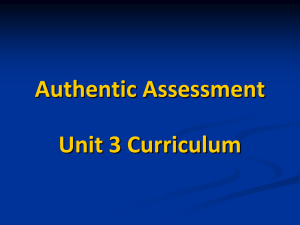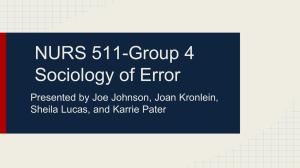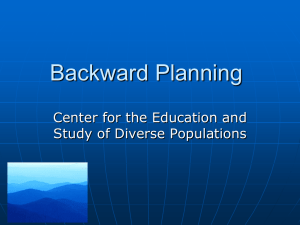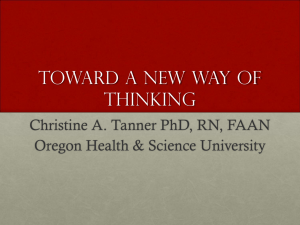Conceptual Framework - Nebraska Medical Center
advertisement
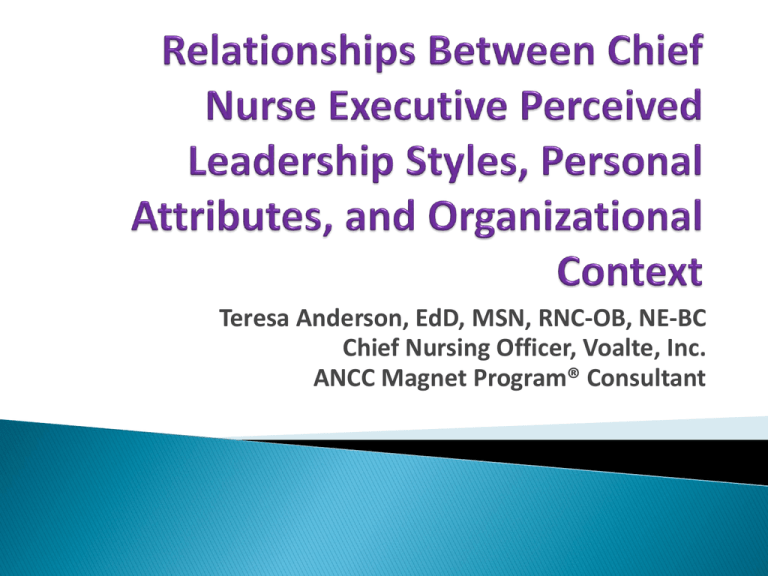
Teresa Anderson, EdD, MSN, RNC-OB, NE-BC Chief Nursing Officer, Voalte, Inc. ANCC Magnet Program® Consultant This quantitative, descriptive, correlation study examined the relationships of the perceived levels of transformational and authentic leadership among Chief Nurse Executives (CNEs) of acute care U.S. hospitals with personal attributes and organizational context variables. Transformational leadership ◦ ◦ ◦ ◦ ◦ Organizational Context Variables ◦ ◦ ◦ ◦ ◦ ◦ Idealized attributes Idealized behaviors Inspirational motivation Intellectual stimulation Individual consideration Licensed bed size Profit status Religious affiliation Magnet® status Healthy Work Environment® Nursing professional practice culture Authentic leadership ◦ ◦ ◦ ◦ Transparency Moral/Ethical Balanced Processing Self-awareness Personal Attributes ◦ ◦ ◦ ◦ Age Leadership tenure Level of Education Type of Education No consistent definition of “success” for nursing leadership was evident within the literature reviewed. Successful nurse executives must possess strong communication, management, and business skills. (Corning, 2002; Dunham & Fisher, 1990; Kirk, 2008; Poulin, 1984; Upenieks, 2002, 2003) Preliminary work confirms that transformational and transactional leadership form a meaningful framework in which to assess self and staff perceptions of leadership style. (Avolio & Bass, 2004; Bass & Riggio, 2006; Burns, 1978; Dunham-Taylor & Klafehn, 1995; Judge & Piccolo, 2004; Walumbwa et al., 2007) ANCC describes transformational leadership as a component of success in Magnet Recognized® facilities. (Aiken et al., 2008; ANCC, 2008; McClure & Hinshaw, 2002) Authentic leadership has captured the interest of social and behavioral scientists as a basis for other forms of leadership. (Avolio & Gardner, 2005, Gardner et al., 2005; George, 2003) Authentic leadership is based upon positive psychology, is evident in genuine, ethical, and optimistic individuals, and develops through self-reflection of trigger events and meaning within the leadership role. (Michie & Gooty, 2005; Shamir & Eilam, 2005; Sparrowe, 2005) AACN identifies authentic leadership as a key component of a Healthy Work Environment®. (AACN, 2005; Shirey, 2006) Successful Nursing Leadership ANCC Magnet Recognition® Organizational Context Personal Attributes Individualized Consideration Intellectual Transformational Stimulation Leadership Inspirational Motivation Idealized Influence (attributes/ behaviors) Self Awareness Authentic Leadership Ethical Moral AACN Healthy Work Environment® Balanced Processing Transparency Positive Psychology Figure 1. Anderson Predicted Nursing Executive Leadership Conceptual Model Full Range of Leadership Model Effective Transformational Contingent Reward Management By Exception Active Passive Active Management By Exception Passive Laissez-Faire Ineffective Figure 2. Full-Range of Leadership Model. Bass, B.M., & Avolio, B.J. (1990). Manual for the Multifactor Leadership Questionnaire. Menlo Park, CA: Mind Garden, Inc. Copyright 1990 by Bruce Avolio. Used with permission. Population ◦ Active CNE members of the American Organization of Nurse Executives (AONE) Hosted CSM webpage linking to ◦ Online survey at Mind Garden, Inc. website Multifactorial Leadership Questionnaire (MLQ) Authentic Leadership Questionnaire (ALQ) Demographic Data Survey Data spreadsheet ◦ .csv file uploaded to PASW and compatible with Excel Multifactorial Leadership Questionnaire ◦ 45 items ◦ Nine subscales total, 5 subscales for Transformational Leadership (idealized attributes, idealized behaviors, inspirational motivation, intellectual stimulation, and individualized consideration) Authentic Leadership Questionnaire ◦ 16 items ◦ Four subscales (transparency, moral/ethical, balanced processing, self-awareness) Demographic Data Survey ◦ 12 items 184 completed surveys ◦ 1 subject eliminated for substantial missing data ◦ 39 subjects eliminated for failure to meet study inclusion criteria 144 subjects included in study data analysis ◦ Sample size differed by variable based upon the number of responses to individual questions ◦ ◦ ◦ ◦ ◦ ◦ ◦ ◦ Represent 38 states Mean age of participants was 53.8 years (range 33 – 69 years) Mean years within their role was 9.8 years (range 0 – 38 years) 80.6% were educated at a masters degree level (35% of these had nursing administration focus) and 8.3% were educated at a doctoral level 88.5% work in organizations aspiring to or having achieved Magnet Recognition® status 64.6% were implementing the AACN Healthy Work Environment ®standards 71.5% were not for profit or identified their organization as not religiously affiliated Mean bed size was 302.91 beds (range 14 – 2,200 beds) The age distribution of the participants represented a non-normal distribution, skewed to the older end of the range Chief Nurse Executive Age Distribution 100 90 80 70 60 50 40 30 20 10 0 Number Percentage 30s 40s 50s 60s 4 24 90 25 2.7 16.7 62.9 17.4 Figure 4. Chief Nurse Executive Age Distribution by Decade Magnet® Status PERSONAL ATTRIBUTES Transformational Leadership ORGANIZATIONAL CONTEXT Age Bed Size Tenure in Executive Role Profit Status Level of Education Type of Education Authentic Leadership Religious Affiliation Nursing Professional Practice Culture Healthy Work Environment® What are the relationships between the perceived levels of transformational leadership (TL) and authentic leadership (AL) of chief nurse executives (CNEs) in U.S. acute care hospitals? The research question was fully supported ◦ There were statistically significant positive relationships between TL and AL on all subscales as analyzed by Spearman Rho Correlations (between the five TL subscales and the four AL subscales) Transparency Moral/ Ethical Balanced Processing Self Awareness Idealized Attributes(A) 0.36** 0.28** 0.35** 0.41** Idealized Influence (B) 0.32** 0.41** 0.39** 0.33** Inspirational Motivation 0.41** 0.35** 0.38** 0.42** Intellectual Stimulation 0.28** 0.28** 0.47** 0.51** Individual Consideration 0.34** 0.36** 0.52** 0.48** Variable Note. *p < .05, **p < .01 Associations were all significant at p < .01 with effect size ranging from small to large. Cohen (1988) defines significance: .10 - .29 = small; .30 - .49 = medium; > .50 = large . Study M Normative M Idealized Influence (Attributes) 3.47 2.95 Idealized Influence (Behaviors) 3.60 2.99 Inspirational Motivation 3.64 3.04 Intellectual Stimulation 3.45 2.96 Individual Consideration 3.64 3.16 Research variable MLQ Normative Mean Database maintained by Mind Garden, Inc. What are the relationships between the perceived levels of transformational and authentic leadership of CNEs in U.S. acute care hospitals and the organizational context variables of the setting in which the chief nurse executive is employed? Demonstrated mixed findings and the research question was only partially supported ◦ Bed size, profit status, religious affiliation, and Healthy Work Environment showed no association ◦ Magnet Status and NPPC demonstrated positive associations with only two leadership subscales (Idealized Behaviors and Ethical/Moral) There was only one significant relationship between transformational leadership (TL) and the organizational context variables: ◦ The Idealized Behaviors subscale was positively associated with having an active Magnet Recognition® application. (Mann Whitney U-test: U = 364.50, p < .009) There was only one significant relationship between authentic leadership (AL) and the organizational context variables: ◦ The Ethical/Moral subscale demonstrated a small positive association with the presence of a Nursing Professional Practice Culture (Spearman Rho Correlation: 0.20, p <.05) What are the relationships between the perceived levels of transformational and authentic leadership of CNEs in U.S. acute care hospitals and the personal attribute variables of the chief nurse executives? Demonstrated mixed findings and the research question was partially supported Specific Findings: Transformational Leadership subscale positive correlations included: ◦ Intellectual Stimulation and Individual Consideration with age ◦ Intellectual Stimulation, Inspirational Motivation, and Idealized Behaviors with level of education Idealized Attributes showed no associations Level of Education Variable Age Tenure Idealized Attributes 0.10 0.07 0.15 Idealized Behaviors 0.13 0.10 0.19* Inspirational Motivation 0.08 0.15 0.17* Intellectual Stimulation 0.23** 0.10 0.22** Individual Consideration 0.22** 0.04 0.13 Note. *p < .05, **p < .01 Cohen (1988) defines significance: .10 - .29 = small; .30 - .49 = medium; > .50 = large . Specific Findings: Authentic Leadership subscale positive correlations include: ◦ Moral/Ethical, Balanced Processing, and Self-Awareness with age ◦ Moral/Ethical with tenure and level of education Transparency showed no associations. Type of education could not be analyzed fully due to excessive stratification of the findings; however, ancillary analyses were conducted relative to master’s education in nursing administration, with no significant findings. Variable Level of Education Age Tenure Transparency 0.02 -0.03 Moral/Ethical 0.20* 0.22** 0.15 Balanced Processing 0.21* 0.01 0.10 Self-Awareness 0.20* 0.14 0.10 -0.01 Note. *p < .05, **p < .01 Cohen (1988) defines significance: .10 - .29 = small; .30 - .49 = medium; > .50 = large . Are there statistically significant differences in MLQ and ALQ sub-scores by level of education (Diploma, ASN, BSN degrees vs. Master’s degree vs. Doctoral degree) of chief nurse executives (CNEs) in US acute care hospitals? ◦ The TL subscale Intellectual Stimulation revealed significant differences by education level (master’s and doctoral higher) ◦ The AL subscale Moral/Ethical revealed significant differences by education level (master’s higher) U Test U p Mean Rank Sum of Ranks Intellectual Stimulation Diploma/ASN/BSN 509.05 .003 40.34 645.50 Master’s degree 70.11 8132.50 Diploma/ASN/BSN 43.50 .013 11.22 179.50 Doctoral degree 18.88 226.50 Moral/Ethical Diploma/ASN/BSN 458.00 .000 37.13 594.00 Master’s degree 70.02 8052.00 Diploma/ASN/BSN 53.00 .047 11.81 189.00 Doctoral degree 18.08 217.00 The significance value of p was determined to be at .025 (.050/2) for the pair-wise comparison. All statistical associations were in a positive direction; as one variable increased so did the other Transformational and authentic leadership were significantly associated with each other Transformational and authentic leadership were only minimally associated with organizational context variables Transformational and authentic leadership were positively associated with personal attributes more often than with organizational context variables Personal Attributes Organizational Context Idealized Attributes Transparency Idealized Behaviors ANCC Magnet Recognition® No Intent No Application Active Application Magnet Status Ethical Moral Age Level of Education Type of Education Tenure Individualized Consideration Self Awareness Profit Status Religious Affiliation Licensed Bed Size NPPC Intellectual Stimulation Balanced Processing NOTE: All associations were positive Inspirational Motivation AACN Healthy Work Environment® Positive Psychology Figure 5. Anderson Nursing Executive Leadership Conceptual Model. Arrows represent statistically significant associations between variables. Research Question 1 CNEs who perceive themselves as transformational leaders, also perceive themselves as authentic leaders ◦ authentic leadership as a basis for other forms of leadership (Avolio & Gardner, 2005) Although associated, transformational and authentic leadership are two distinctly different leadership styles (Walumbwa et al., 2008) Transformational and authentic leadership are strongly related, which might have implications for ◦ screening and selection of future leaders ◦ education and development of future leaders Research Question 2 The relationships between transformational and authentic leadership and organizational context were not consistent with the results of previous studies (AACN, 2005; ANCC, 2008; Bass & Riggio, 2006; Dirks & Ferrin, 2002; Drenkard, 2009; Dunham-Taylor, 2000; McClure & Hinshaw, 2002; Shirey, 2006; Upenieks, 2003) suggesting ◦ the need for further study in this area The moral/ethical component of authentic leadership did not associate with religious affiliation as suggested by positive psychology findings (Dirks & Ferrin, 2002; Dunham & Fisher, 1990; Gardner, Avolio, Luthans, May, & Walumbwa, 2005; Michie & Gooty, 2005; Upenieks, 2002, 2003) Research Question 2 The relationship between transformational leadership and the ANCC Magnet Recognition Program® was minimal, which ◦ does not validate or negate this leadership style as critical to building an excellent nursing practice environment (ANCC, 2008) The relationship between authentic leadership and the implementation of the AACN Healthy Work Environment was not significant, which ◦ suggests the need for further research to validate this leadership style as a key component of a healthy work environment (AACN, 2005) Research Question 3 The mean age of CNEs in the study was 53.8 years (median 55 years), and 80.5% were over the age of 50 years, which may impact ◦ turnover and vacancy of CNEs nationally within the next 10 – 15 years ◦ conscious attention to CNE succession planning is needed now The relationship between age and authentic leadership suggests ◦ support for findings related to conscious self-reflection and trigger events over time (Avolio & Gardner, 2005; Ilies et al., 2005) Research Question 3 The relationship of education level and transformational leadership ◦ supports the findings of others (Dunham & Klafehn, 1990) ◦ could be impacted by Magnet Program® eligibility requirements The mean tenure of Chief Nurse Executives is 9.8 years suggesting that ◦ CNEs seek advancement within different facilities, or experience dissatisfaction or burn-out in the role (Jones, Havens, Thompson, & Knodel, 2008) ◦ mobility of chief nurse executives may mediate the impact of setting or organizational context ◦ CNE tenure may implicate experience as a factor in leadership success (Henderson, 1995; Linton & Farrell, 2009) Education Availability of nursing administration master’s programs ◦ Declined between 2004 and 2008 (Institute of Medicine, 2011) Impact of DNP programs on educational preparation of CNEs (Institute of Medicine, 2011) Competition between academia and practice for highly qualified nurses to fill openings ◦ 54.5% vacancies, and 20.1% additional faculty needed (Tracy & Fang, 2010) ◦ Flexibility of curricula ◦ Creative solutions – dual roles or subsidized faculty positions Practice Transformational leadership may develop as a result of authenticity (self-awareness, balanced processing, moral/ethical, and transparency) or concurrently with it Authenticity develops as a result of reflection upon the events of one’s life over time, which suggests ◦ a possible connection to age, experience and level of education Further analysis of relationships between authentic leadership and the other forms of leadership within the Full Range of Leadership Model is needed (Bass & Avolio, 1990) Transformational Leadership + Authentic Leadership ? Contingent Reward Management by Exception - Active Management by Exception - Passive Laissez-Faire Findings suggest a positive relationship between transformational and authentic leadership as perceived by CNEs The relationship between age, level of education, tenure, and leadership style suggests that personal attributes are important determinants of leadership style and may possibly mediate success The impact of personal attributes, leadership style, and the development of leaders will be critical as the majority of nurse executive incumbents retire over the next 10 – 15 years Transformational leadership and authenticity may provide leaders with the means to channel their “passion” for the nursing executive role into strategic vision and operational success. Next steps… Analysis of remaining data Chief Nurse Executive Life Stories 402-556-4274 – home 402-679-1551 – cellular tlanderson@cox.net tlanderson@voalte.com www.cnoadventure.com www.Voalte.com Aiken, L. H., Clarke, S. P., Sloane, D. M., Lake, E. T., & Cheney, T. (2008). Effects of hospital care environment on patient mortality and nurse outcomes. Journal of Nursing Administration, 38(5), 223-229. American Association of Critical-Care Nurses [AACN]. (2005). AACN standards for establishing and sustaining healthy work environments a journey to excellence. Retrieved from http://www.aacn.org/WD/HWE/Docs/ HWEStandards.pdf American Nurses Credentialing Center. (2008). Application manual magnet recognition program. Silver Spring, MD: Author. Avolio, B. J., & Bass, B. M. (2004). Multifactor leadership questionnaire: Manual and sampler set (3rd ed.). [Adobe Acrobat 7.0 Document]. Retrieved from http://www.mindgarden.com/login/55442/50380 Avolio, B. J., & Gardner, W. L. (2005). Authentic leadership development: Getting to the root of positive forms of leadership. The Leadership Quarterly, 16, 315-338. Bass, B. M., Avolio, B. J., Jung, D. I., & Berson, Y. (2003). Predicting unit performance by assessing transformational and transactional leadership. Journal of Applied Psychology, 88(2), 207-218. Bass, B. M., & Riggio, R. E. (2006). Transformational leadership (2nd ed.). Mahwah, NJ: Lawrence Erlbaum Associates. Burns, J. M. (1978). Leadership. New York, NY: Harper & Row. Cohen, J. (1988). Statistical power analysis for the behavioral sciences (2nd ed.). St. Paul, MN: West Publishing. Corning, S. P. (2002). Profiling and developing nursing leaders. Journal of Nursing Administration, 32(7/8), 373375. Dirks, K. T., & Ferrin, D. L. (2002). Trust in leadership: Metaanalytic findings and implications for research and practice. Journal of Applied Psychology, 87(4), 611-628. Drenkard, K. (2009). The Magnet imperative. Journal of Nursing Administration, 39(7/8), S1-S2. Dunham, J., & Fisher, E. (1990). Nurse executive profile of excellent nursing leadership. Nursing Administration Quarterly, 15(1), 1-8. Dunham-Taylor, J. (2000). Nurse executive transformational leadership found in participative organizations. Journal of Nursing Administration, 30(5), 241-250. Dunham-Taylor, J., & Klafehn, K. (1995). Identifying the best in nursing executive leadership: Part 1 questionnaire results. Journal of Nursing Administration, 25(6), 68-70. Gardner, W. L., Avolio, B. J., Luthans, F., May, D. R., & Walumbwa, F. (2005). “Can you see the real me?” A self-based model of authentic leadership and follower development. The Leadership Quarterly, 16, 343-372. George, B. (2003). Authentic leadership: Rediscovering the secrets to creating lasting value. San Francisco, CA: JosseyBass. George, V., Farrell, M., & Brukwitzki, G. (2002). Performance competencies of the chief nurse executive in an organized delivery system. Nursing Administration Quarterly, 26(3), 34-43. Henderson, M. C. (1995). Nurse executives: Leadership motivation and leadership effectiveness. Journal of Nursing Administration, 25(4), 45-51. Ilies, R., Morgeson, F. P., & Nahrgang, J. D. (2005). Authentic leadership and eudaemonic well-being: Understanding leader-follower outcomes. The Leadership Quarterly, 16, 373-394. Institute of Medicine. (2011). The future of nursing: Leading change, advancing health. Washington, DC: National Academies Press. Jones, C. B., Havens, D. S., Thompson, P. A., & Knodel, L. J. (2008). Chief nursing officer retention and turnover: A crisis brewing? Results of a national survey. Journal of Healthcare Management, 53(2), 85-102. Judge, T. A., & Piccolo, R. F. (2004). Transformational and transactional leadership: A meta-analytic test of their relative validity. Journal of Applied Psychology, 89(5), 755768. Kirk, H. (2008). Nurse executive director effectiveness: A systematic review of the literature. Journal of Nursing Management, 16, 374-381. Linton, J., & Farrell, M. J. (2009). Nurses’ perceptions of leadership in an adult intensive care unit: A phenomenologic study. Intensive and Critical Care Nursing, 25, 64-71. McClure, M. L., & Hinshaw, A. S. (Eds.). (2002). Magnet hospitals revisited: Attraction and retention of professional nurses. Washington, DC: American Nurses Publishing. Michie, S., & Gooty, J. (2005). Values, emotions, and authenticity: Will the real leader please stand up? The Leadership Quarterly, 16, 441-457. Poulin, M. (1984). The nurse executive role: A structural and functional analysis. Journal of Nursing Administration, 14, 9-14. Shamir, B., & Eilam, G. (2005). “What’s your story?” A lifestories approach to authentic leadership development. The Leadership Quarterly, 16, 395-417. Shirey, M. (2006). Authentic leaders creating healthy work environments for nursing practice. American Journal of Critical Care, 15(3), 256-268. Sparrowe, R. T. (2005). Authentic leadership and the narrative self. The Leadership Quarterly, 16, 419-439. Tracy, C., & Fang, D. (2010). Special survey on vacant faculty positions for academic year 2010-2011. Retrieved from http://www.aacn.nche.edu/IDS/pdf/vacancy10.pdf Upenieks, V. V. (2002). What constitutes successful nurse leadership? A qualitative approach utilizing Kanter’s theory of organizational behavior. Journal of Nursing Administration, 32(12), 622-632. Upenieks, V. V. (2003). Nurse leaders’ perceptions of what compromises successful leadership in today’s acute inpatient environment. Nursing Administration Quarterly, 27(2), 140-152. Walumbwa, F. O., Lawler, J. J., & Avolio, B. J. (2007). Leadership, individual differences, and work-related attitudes: A crosscultural investigation. Applied Psychology: An International Review, 56(2), 212-230. Walumbwa, F. O., Avolio, B. J., Gardner, W. L., Wernsing, T. S., & Peterson, S. J. (2008). Authentic leadership: Development and validation of a theory-based measure. Journal of Management, 34(1), 89-126. doi: 10.1177/0149206307308913


